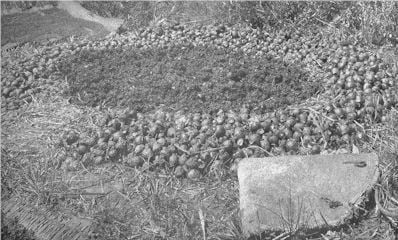In the preparation of lowak, the pods in the interior of the drying piles do not dry, but turn into a soft, moist, rotten mass, the seeds themselves, however, retaining their freshness. When the piles are opened the dry pods are thrown in a pile by themselves to be made into lowak, but these moist, decomposing pods are differently treated and produce a superior grade of seed having a different name, stontablaks (stont”-a-blaks). The rotten pods, denuded of their covering of dry ones, are pounded to a pulpy mass with a site. According to information from the Indians, the pounded pulp is further exposed until dry, and is then screened and winnowed, being thus left in the same form as lowak, suitable for cooking as shiwulinz, but not as lolensh and shnaps.
Shiwulinz

When required for cooking, the dried seeds, either lowak or stontablaks, are first roasted, shell and all, then cracked, and the shells winnowed out from the broken seeds on a shaker. The seeds, called in this condition lint, are then boiled, forming a sort of mush to which the Indians apply the same name.
The word is derived from sbi’-wi, meaning to shake or winnow, and refers to the winnowing of the shells from the cracked seeds. Among the younger women the cracking is often done in a hand coffee mill, but the usual instrument is the primitive meeting stone.
The roasting of lowak, preparatory to the making of shiwulinz, is now usually done in a frying pan, but the primitive method of roasting with live coals in a wokas shaker is still occasionally used by some of the old people. This operation, as witnessed at one of the wokas camps on Klamath Marsh, is conducted as follows: About 3 quarts of lowed were placed in a shaker and several pieces of live coal from a lodge pole pine fire were laid on top of the seeds. Most of the coals were 1 inch or less in diameter; a few were 3 or 4 inches long and 2 or 3 inches thick. The seeds and coals were then tossed so as to roll over and over each other in the shaker, the contents going into the air from the farther margin of the shaker and falling in the middle. After a few minutes the coals began to cool. They were then brought to the top of the mass of seeds by a rotary motion, the shaker was set on the ground, and a little vigorous fanning with another empty shaker soon brought the coals to a lively heat. Then the tossing went on again as before until the roasting was completed. The whole process requires dexterity, both to keep the coals in motion so that the shaker will not burn and to roast the seeds evenly without scorching them.
Another form of food prepared from lowak is named stilinsh (stil’-insh). This differs from sbiwulinz in that the shells are not winnowed out on a shaker, but are skimmed from the boiling pot while the seeds are cooking. The name is derived from sterling, to skim, a word now applied to various operations, from the removal of cream from milk to the washing of gold in a miner’s pan. In earlier times a food named talwas (tal’-was) was prepared from lowak. This was essentially the same as shiwulinz and stilish, but the boiling was done in a water-tight basket into which hot stones were dropped, a method of cooking not practiced among the Klamaths at the present day.


